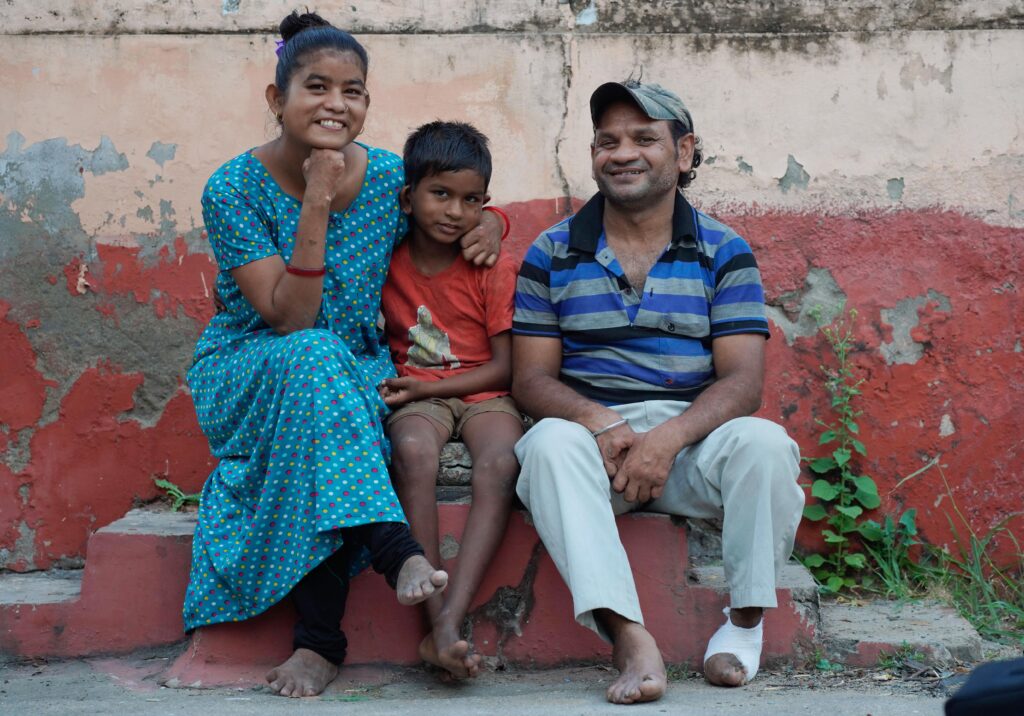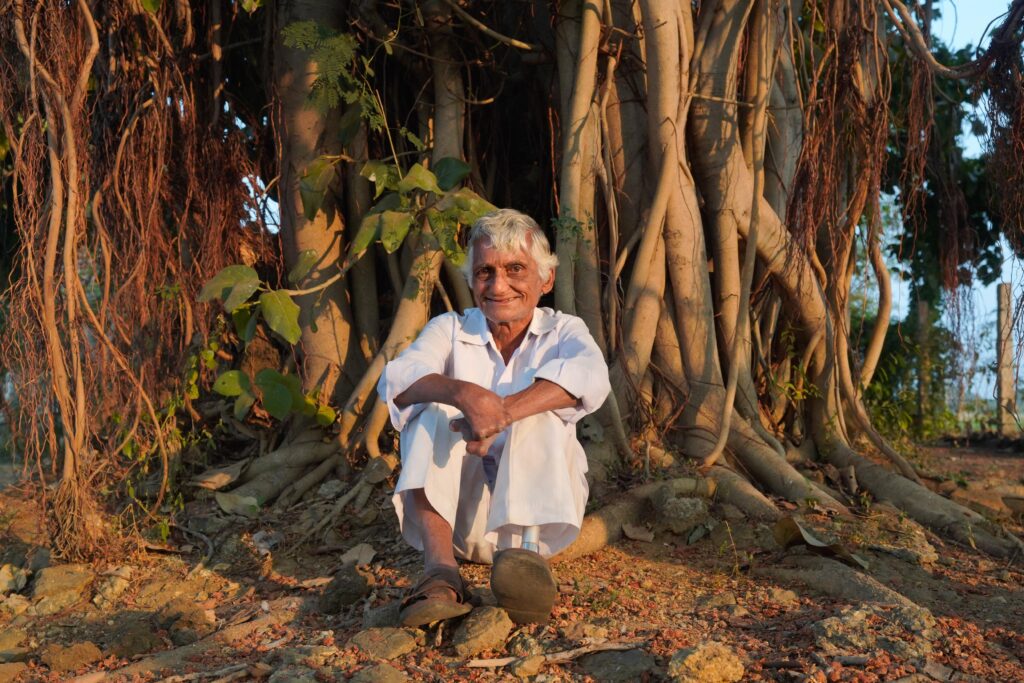
Maruti Bondre, 70, feeds lunch to his wife Chandrakala, at the hostel for leprosy patients and leprosy-cured rehabilitated persons, run by Maharogi Sewa Samiti (MSS), in the village Anandwan, Taluka Warora, District Chandrapur, Maharashtra, India.
His wife has lost all her fingers and is affected by lagophthalmos (inability to close one or both eyes completely) due to leprosy. he has also lost his fingers partially. Every day, he feeds his wife, and then he has food.
Leprosy looks like a disease of the past. Data and numbers also convey it because it doesn’t count the after-effects of any tragedy or illness.
However, have we thought about the people who are still living through the wounds of leprosy?
How are they living now?
Where are they living?
How they survived the social, economic and most importantly emotional trauma caused by leprosy?
How did leprosy cause the trauma?
Affected people were ostracised by the societies, villages, and even their close ones and family.
Imagine! You can play with your friends, swim in the pond with neighbours, use each other’s soap to bathe, visit relatives, and attend family functions but soon after no one wants to even talk with you or associate with you.
How does it feel?
Let’s know a few examples of stigma and discrimination leprosy-affected people had to face:
*A son is crying for his mother. The mother also crying for her son but she is unable to accept this person as her son. Such was the fear, stigma and discrimination of leprosy. This son who is now 70 years old still cries for his mother.
*Wife was admitted to the hospital for the ulcers caused by leprosy. She receives news in the hospital that her husband doesn’t want to be with her anymore. He is getting married somewhere else.
*An adolescent boy used to play and swim in the river with his friends. He used to visit his neighbours and relatives. But after the infection, there was nothing for him. For many years there was no hope in life until he met a young woman who was also affected by leprosy and left alone by her family.
*There was a young woman. Her relatives considered her dead for them after she was diagnosed with leprosy.
The list of such examples is long!!
Left alone by the close ones, ostracised by society, there was no one and there was no place for the leprosy-affected people.
Civil societies and social organisations across India came to treat and rehabilitate the leprosy-affected people. I visited such two organisations, Sahyog Kushtha Trust and Maharogi Sewa Samiti, in Gujarat and Maharashtra, respectively.
These organisations regenerated the ground of new families, relations, inclusiveness, new life and importantly a community for leprosy-affected people.
People regained their dignity, discovered their potential and transformed their life wading through the marshy land of leprosy disease and trauma.
Subtlety and intricacies of human emotions are difficult to measure and often, unprocessed.
This old age when you are seeing death is close, you feel so lonely.
You have a sense that there is no one for you but you still long for someone unseen or unknown. Or maybe you long for the one who left you in the lurch or you long for the one who just hug you or assure you “Don’t worry I’m there”.
You also know it wasn’t the intentions of close ones to disassociate from you but their weaknesses in understanding this disease and various fear that come along with infectious diseases like leprosy. This pain further increases to see those close ones again.
Such is the trauma and pain people are going through now.
‘We’ll not leave each other’

Kaushalya Raut tenders her husband Vinayak who is ill, at their house, in the leprosy colony at MSS, in Somnath village, Chandrapur, Maharashtra, India.
Kaushalya was young and married when she was diagnosed with leprosy around 50 years back. She had lumps on her face and body. Her husband refused her.
Someone told her about the Maharogi Sewa Samiti (MSS) for the treatment of leprosy and a hostel for rehabilitated patients. There she met Vinayak Raut. He was also leprosy affected and his wife and family disassociated from him.
They would be doing community farming at MSS’s Somnath Centre. They liked each other and got married. They said to each other “We will not leave each other like our families.”
I asked her, ‘Do you miss anyone in your parents’ family or your husband’s family?’
She said, “I died for everyone after I got leprosy. So, what is the purpose of remembering or missing anyone now”.
She didn’t say but she seemingly misses her own people at this age. She longs for someone unseen and unknown who can give her a sense of love and strength.
‘Longing to see the close ones’

Parvati Istam, 80, was expecting her grandson to visit her and take her back home during the festival of Holi but he didn’t come nor he called.
Is there a grandson who was supposed to take her home?
She lives with other women in the colony for leprosy rehabilitated persons, at MSS, in Somnath, Maharashtra.
‘I don’t miss my family’

Mehndi is being drawn in the hand of Janki Raut, at the hostel for leprosy patients and for leprosy-cured rehabilitated persons, in the village of Anandwan, Maharashtra, India.
Janki’s third child was a toddler when she had to leave her home because of leprosy. It’s been forty years since she left her home. Initially, she visited her home hardly four times. She wasn’t treated well at home and by the villagers after she was infected with leprosy.
She has no contact with her husband’s and her parents’ families. The doctor in the village told her, “It’s the most dangerous among all diseases.
‘Mehndi brings smile’

Twenty years back (around the year 2000), Indira was affected by leprosy and while taking treatment at the leprosy hospital, her husband conveyed to her; he is going to marry someone else.
She was stunned at first but then she said, helplessly “You can marry as many times as you want. What can I do now?” her smiling face dimmed as she shares her past.
She said, “It looks sad and terrible to see our hands and legs without fingers. Gradually, we have found a way to see ourselves as happy. We used to think what is the purpose of mehndi in our hands. What will be drawn in these hands without fingers? Then a dot of mehndi is drawn on the tip of the lost finger. It gives us a big smile”.
‘Sleep is the only best friend’

Sleep is Bachchu Bhai Chavda’s (57) best friend these days. He was an adolescent when diagnosed with leprosy, which was left untreated until it was too late. At 45, he lost his left eye due to leprosy. His legs and fingers are deformed. He was married and separated twice due to leprosy and eventually ended up at the hostel, where all his medical needs are taken care of, in Rajendra Nagar, Gujarat.
‘It’s a love marriage’

Leela Bai Jivtode (R) and Pundalik Jivtode, who are around 65 years old, married for forty years.
Pundalik was an orphan and he was staying at MSS.
Leela Bai was around 10-12 years old, she was diagnosed with leprosy. Her family and villagers discriminated against her. She was admitted to the MSS.
There she met Pundalik.
Pundalik said, “Our marriage is a love marriage (he laughed). I was seeing leprosy patients and was living among them since childhood at MSS. I never had leprosy. Even if I had leprosy I never got afraid of it.”
“I proposed to Leela if she wants to marry me. She said yes.”
Leela Bai had limb transplantation after her leg was severely infected and deformed due to leprosy.
‘Why isn’t God calling me?’

70-year-old Shamubai Kumbhare with her hostel friends during a leisurely evening. The hostel is called ‘Apulki’ (house of affection), at MSS, village Anandwan, Maharashtra.
Shamubai is cured of leprosy but she has chosen to stay back in the hostel to take care of herself better and not be a burden on her children.
Her legs are completely deformed and her hands’ fingers are partially deformed due to damage to her nerve because of Mycobacterium Leprae (leprosy).
She said with a big smile in a soft voice “I don’t know why God isn’t calling me when I am also ready.”
She passed away three months after this photo.
‘Comfort in each others’ company’

Sonam Yadav, 22, with her husband Rajesh Yadav, 38, and 5-year-old son Ravi, at her quarter, in Rajendra Nagar.
Sonam’s family abandoned her as she had severe leprosy in her adolescence. The Sahyog Kushtha Yagna Trust provided her with a place to stay and proper healthcare. She met her husband Rajesh at the facility.
Though he came to the centre as a patient at a young age, he has been working as a healthcare provider for more than a decade now. He was trained on how to dress ulcers/wounds of leprosy patients.
“When I had no leprosy, I used to swim in the river with my friends. We used to share soap. I used to visit my relatives and friends without hesitation. After I contracted leprosy, everything changed. I became lonely,” he says.
Sonam and Rajesh found comfort in each other’s company and the centre made arrangements for their marriage, gave Rajesh a job and provided them with housing.
‘Tree plantations keep away negative thoughts’

Mohammad Arab, 70, sits under the 38 years old banyan tree he planted in Anandwan.
He was diagnosed with Leprosy at the age of 7. He had to leave his home and village because his parents were worried about his younger siblings’ future. Until he stayed at home, he had separate plates to eat food.
In 2007, when his father passed away, his siblings didn’t inform him. Sometimes, he misses his home and his siblings. He said, “Plantation work gives me peace and keeps my mind busy from the negative thoughts. I have planted 45 species of plants in the last 45 years.”
‘Healing Empathy’

The nurse Roshana tenders the patient Chandrakala Bondre whose hand is deformed by Mycobacterium Leprae (leprosy), at the hostel for leprosy patients and for leprosy-cured rehabilitated persons, in village Anandwan.
As of 2021-22, the number of leprosy cases in India is 75, 394, accounting for 53.6 % of the world’s leprosy cases.
This photo story was made possible by a Pulitzer Center on Crisis Reporting grant.
***
Rohit Jain is an independent social documentary photographer and human interest story writer based in India. His work focuses on human and life development through documentary photography. He goes further and commits himself to doing some deep photo stories about life, its ups and down and social issues. He hopes to bring humanity closer and develop empathy through the photos and the stories. He has covered tribal life and culture, forced displacement/migration and deprivation caused by modern development and social conflicts, women’s health, public health, education, early marriage, livelihood and land rights. Currently, he is associated with UNICEF India as a consultant photographer. He has worked independently with World Bank, Vitamin Angels, Evidence Action, Norwegian Consulate General – Mumbai, Tenure Facility – Sweden, Malaria No More, Girl Up India, Haq – Center for Child Rights and more. Various media outlets have published his works. His works on Bhopal Gas Tragedy and Child Marriage had solo exhibitions. He is a multiple-time grantee of the Pulitzer Center on Crisis Reporting.